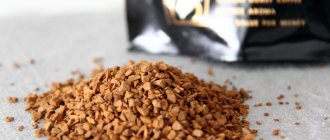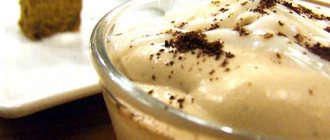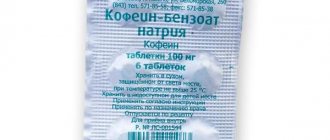Chemical composition of raw coffee beans
The biochemical formula of coffee is quite complex. The basis of the green product is water, fiber and oils. Coffee beans also contain the following components:
- caffeine;
- chlorogenic acid (gives the drink an astringent taste);
- mineral salts;
- theobromine;
- protein;
- trigonelline (during frying it contributes to the appearance of a characteristic aroma).
At least fifty percent of the composition of green grains is carbohydrates. With their help, it is possible to obtain a characteristic crema in espresso. They are the basis of the drink. It also contains a lot of acids that begin to release during heat treatment. They have a positive effect on the digestive system and the functioning of the stomach.
With the help of tannins, it is possible to obtain an astringent, bitter taste. When milk or cream is added to the drink, the structure changes and the bitterness is partially eliminated.
The caffeine contained in the beans has an invigorating effect, stimulates the activity of all systems and slightly increases blood pressure. Depending on the variety, the concentration of the alkaloid is different. It has been noted that there is more caffeine in Robusta than in Arabica. In addition, the amount of the substance depends on the method of processing the product and the growing region.
The beans also contain coffee ash, which consists of manganese, magnesium, potassium, sodium and calcium.
What is "body"?
Body is one of the key characteristics of coffee consumed by professionals. This list also includes acidity, sweetness, and aftertaste. To put it very simply, the body is about the tactile sensations in the mouth that you experience when sipping the drink you are tasting. Feelings of density or lightness, richness, richness of taste.
Often a gradation from light to heavy is applied to the coffee body. To understand it, imagine that you first hold skim milk in your mouth, then whole milk, and then cream. If we apply coffee terminology to dairy products, it turns out that low-fat milk has a light body, whole milk has a heavier body, and cream has a very heavy, dense body.
Density, heaviness or, conversely, lightness refer to the intensity of tactile sensations. The coffee body has one more characteristic - the quality when you evaluate your sensations as pleasant or not very pleasant. A high-quality body can be called silky, creamy, smooth, creamy. Poor quality – dusty, dry, astringent.
Composition of roasted coffee beans
During heat treatment, the composition of the coffee bean changes. The longer this process, the more significant the transformation:
- water . The liquid evaporates, the concentration of other substances, taking into account the changed mass, increases;
- sugar . When the beans are roasted, caramelization occurs and they acquire a brown tint;
- cellulose . There is a breakdown into alcohols, acids and amino acids;
- fats _ Their partial decomposition into acids is noted;
- caffeine _ After heat treatment, it is contained in the grains in almost the same quantity as initially. Taking into account the fact that the product is deprived of moisture, the concentration of dry components increases. Therefore, relative to the alkaloid content in green fruits, it becomes greater in fried ones;
- chlorogenic acid . Roasting leads to a significant decrease in its concentration, but it still remains so high that it forms a bitter taste and characteristic aroma;
- trigonneline . Heat treatment leads to the release of nicotinic acid from it.
During the process of roasting fruits, the components decompose into many organic compounds. In addition, a reaction occurs between them, as a result of which new components are formed. The result is a special aroma and taste.
The amount of antioxidants in coffee during heat treatment increases significantly as a percentage of other components.
What does a caffeine molecule look like?
Let's take a closer look at the structure of the caffeine molecule. This will help you understand how it works. Scientists have found that raw coffee beans contain half the carbohydrates. They are a kind of fuel for our body. They give energy to every cell of ours. These carbohydrates are mainly simple sugars (fructose, sucrose) and polysaccharides (fiber, cellulose, pectin). These substances are simply irreplaceable for our brain. They are directly involved in its nutrition. Sugars and polysaccharides nourish nerve cells. This ensures normal functioning of the brain and nervous system.
Coffee also contains minerals:
- magnesium;
- potassium;
- calcium.
These are the most important minerals of inorganic origin. They are found in bones and muscles. Without them, proper functioning of blood vessels and the brain is impossible. These minerals ensure the normal functioning of the heart muscle. Scientists have found that raw coffee beans contain about 850 different essential compounds. But in the fried product their quantity is reduced by almost two and a half times and amounts to 350 units. They provide the amazing aroma of coffee. It is not surprising that this drink has long been recognized as the most fragrant.
What does instant coffee contain?
The coffee content in instant drinks does not exceed twenty percent. This product is noticeably different in composition from the natural one. To make it, the raw materials are boiled for up to ten hours. All initially present flavoring and aromatic substances remain in the thicket, which is not used in the future. The finished product contains only the presence of an invigorating alkaloid and a small amount of acids. About eighty percent of ersatz consists of various flavor enhancers, preservatives, stabilizers, as well as dyes and flavors.
Cheap instant products may also contain chicory, but nothing is said about this on the packaging.
Even the most expensive brands do not contain one hundred percent high-quality Arabica beans. As a rule, damaged, rejected Robusta beans, characterized by a high concentration of caffeine, are used.
Blend vs Single Origin
The concept of SINGLE ORIGIN (single origin) means coffee beans collected from one region, one farm, while BLEND is a mixture of different coffee varieties. The term micro lots is used to refer to special varieties of coffee specially grown within a small farm or on a specific area of a plantation.
MICROLOT is one type of grain, collected from one farm, processed in one way. approx. Editorial staff
The question arises: is such a division necessary for the average coffee drinker? Yes, because the taste of coffee is affected by where and in what conditions it is grown. As we will now see, country, region, farm, processing method, variety of coffee tree and much more affect the taste and aroma of our drink.
SINGLE ORIGIN is a coffee bean collected from one farm, processed in one way and roasted according to one profile. Typically, these are high-quality coffees with unique flavor characteristics that roasters do not want to overshadow or mix with other varieties.
BLEND (coffee blend) is created when a mixture of two coffee varieties gives a better taste than the same two varieties separately and in order to achieve taste stability. Let's say there is a light, fruity Ethiopia, but it lacks a little body. (For example, blends are often used to make espresso)
While SINGLE ORIGIN is generally more prized by specialty drinkers (and costs more) than BLEND, they can both be excellent. There are bad SINGLE ORIGIN and good BLEND, they just have different concepts. Try it and don't give up on coffee just because it's a blend of beans from three countries.
At the same time, immerse yourself in the world of SINGLE ORIGIN by tasting coffee from different regions. Take Guatemala, which is known for its acidity, balance and spicy notes, then compare it to coffee from Rwanda, which is known for its sweetness and full body. And then, try samples from two different regions of Colombia - say, Nariño and Santander. Get to know the origins and characteristics of the coffees you love.
But remember, just because a country tends to have a certain flavor of coffee, doesn't mean all of its coffee will match that flavor. Be open to new discoveries!
BREAKFAST BLEND (ESPRESSO MIXTURE of two varieties of Arabica Brazil Fine Cup + Ethiopia Sidamo) www.coffeeproject.ru
Vitamins and minerals
The natural product contains not only proteins, fats, carbohydrates and alkaloids, but also vitamins. The composition includes the following:
- AT 3 . It can be obtained from trigonelline under the influence of high temperatures. It has a positive effect on the nervous system and helps normalize metabolism.
- A. This vitamin has a beneficial effect on the development of all organs of the body and helps ensure that beneficial substances are absorbed into the gastrointestinal tract properly.
- E. Helps to activate the body’s protective functions and has a positive effect on the functioning of the reproductive system.
Coffee is an antioxidant, containing a considerable amount of microelements (manganese, magnesium, potassium, as well as sodium and calcium). Due to their presence, it is possible to normalize the functioning of the heart, blood vessels, and brain. In addition, muscle and bone tissues are strengthened.
The effect of coffee on human health
Given its rich chemical composition, coffee has both beneficial and negative effects on health, which directly depends on the individual characteristics of a person and the volume of drink consumed per day. The general picture of the effect of a coffee product on the body is as follows:
- regular intake of pure caffeine in an amount of more than 1000 mg, which coffee is richest in, can cause the phenomenon of addiction, similar to drugs or alcohol;
- coffee has a sufficient diuretic effect, so if signs of dehydration appear, it is necessary to increase the amount of fluid you drink;
- In healthy people who do not suffer from high blood pressure, coffee causes a general increase in pressure by 10-15 mmHg. In people suffering from hypertension and related cardiovascular diseases, blood pressure can increase much more strongly or, conversely, decrease, which greatly limits their ability to drink coffee;
- There is no direct effect of caffeine on the heart. Coffee affects cardiac activity indirectly - increasing blood pressure through a stimulating effect on the central nervous system;
- regular use of unfiltered coffee often leads to an increase in total cholesterol in the blood, which inevitably leads to vascular pathologies, characterizing the appearance of problems with blood pressure;
- improvement in attention, productivity, memory and mood is a temporary phenomenon. Depending on the reactivity of the body, this effect disappears after 30-120 minutes;
- coffee enhances the effect of some painkillers, for example, acetylsalicylic acid and analgin, reduces the risk of Parkinson’s and Alzheimer’s diseases due to a temporary vasoconstrictor effect and a direct effect on the neurons of the brain, the so-called “training” effect of these organs occurs;
- Regular consumption of coffee reduces the risk of developing constipation and cirrhosis of the liver, breast cancer in women;
- in older people, coffee reduces the density of skeletal bones, which can cause cracks and fractures;
- people who drink more than two cups of coffee a day have a high risk of developing urolithiasis;
- Pregnant women are not recommended to drink more than a cup of coffee per day. Due to increased blood pressure due to the effects of caffeine, the development of placental anemia, premature birth and low birth weight of the newborn, as well as miscarriages and stillbirths, is possible.
How much caffeine is in one cup
The concentration of caffeine in coffee depends on several factors:
- Variety Arabica has a higher flavor profile than Robusta. At the same time, the amount of alkaloid in it is significantly less. In a 170 milliliter cup of a robusta-based drink, there will be about 200 milligrams of invigorating substance. In the same cup of Arabica coffee there will be no more than 110 milligrams.
- Degree of roasting . The longer the grains undergo heat treatment, the stronger the drink will be.
- Grinding _ When choosing a coffee preparation method, it is extremely important to consider the degree of grinding of the product. When using a French press or drip coffee maker, large fractions are used. When brewing in a Turk, the grains must be ground into dust. The finer the grinding degree, the greater the amount of alkaloid will be washed out with water, and accordingly, the concentration will be higher.
- Duration and method of preparation. The longer the brew takes, the more caffeine will be in the drink. Therefore, when using a French press, it will be stronger than when using a steam ristretto. Espresso has a higher strength (1700-2250 milligrams per liter); the concentration of alkaloid is lower when using Turkish coffee (380-650 milligrams per liter). A cappuccino has only 350-400 milligrams per liter, and a latte has 270-400 milligrams per the same volume. In addition, if you add not one teaspoon of ground product to the water, but two, the coffee will also be stronger.
This is how it is possible to determine the concentration of the alkaloid in a cup of various coffee drinks:
- espresso – 40-78 milligrams;
- when brewing in a Turk - 80-130 milligrams per 200 milliliter cup;
- cappuccino – 70-80 milligrams;
- instant coffee – 40-100 milliliters;
- decaffeinated – from 2 to 5 milligrams.
Coffee beans are characterized by the presence of a huge number of components. Thanks to their presence, the drink acquires such a refined taste and aroma and has an invigorating effect. In addition, when consumed in moderate doses, it has a beneficial effect on the body.
Coffee (will not) kill
Scientists have discovered a link between mortality and coffee consumption. People who drink a cup of coffee a day are 12 percent less likely to die compared to those who don't drink coffee. With each such statement, there are more and more questions about this drink. What does coffee contain? Does it really give you energy? Why do many people want to sleep after it? Revision N+1
Together with Torrefacto, I decided to understand the biochemistry of coffee and conduct an experiment - of course, on myself.
Coffee acts as a pain reliever, helps with muscle pain, and reduces the risk of liver cancer. In addition, an association was found between coffee consumption and the risk of type 2 diabetes in more than 25 cohort studies in America, Europe and Asia. The results of these studies show that coffee may reduce the risk of diabetes. It is also believed that coffee reduces the risk of developing Alzheimer's disease and can overcome Parkinson's disease.
Scientists argue and study, false studies are born and die, the sociocultural significance of the drink is growing. What is he? Coffee contains more than 1,300 different substances, although not all of them have been studied by science. To date, several groups of biochemical compounds that affect the functioning of the body have been identified. We will look at the main ones.
Coffee makes me happier
Caffeine is responsible for the tonic effect of coffee
is the most consumed psychoactive substance in the world. Caffeine stimulates the central nervous system, affects nerve cells in the brain, increases alertness and reduces fatigue. This is largely achieved by blocking adenosine receptors.
How it works? Adenosine is part of DNA, RNA, adenosine-3-phosphoric acid (ATP), and also plays an important role in biochemical processes, in particular in energy transfer. Adenosine interacts with adenosine receptors. They are found in almost all cells of the body and are responsible for inhibiting intracellular processes. There are four types of receptors: A1, A2A, A2B, A3.
Essentially, adenosine is a marker of fatigue. It gives signals when there is not enough energy in the cells, about being under stress, and warns that the body needs rest: “We are tired - it’s time to sleep.” Adenosine accumulates throughout the day. When tired and adenosine appears, the heart muscle begins to work weaker. You, in turn, feel tired. But if you block adenosine receptors, you can temporarily remove the subjective feeling of fatigue.
Adenosine is an adenosine receptor agonist, a substance that can bind to the receptor and produce a specific effect. But the main antagonists of adenosine receptors are various psychomotor stimulants. One of the most common and gentle forms is caffeine.
giphy.com
Share
Of course, caffeine itself does not carry energy, but thanks to it, the supply of ATP in cells is consumed much more intensively, that is, those molecules that release energy after breakdown. Caffeine blocks adenosine receptors, the feeling of fatigue disappears, cheerfulness comes, even an influx of strength. The body simply uses ATP reserves. During rest, ATP accumulates. If you do not restore these reserves, but continue to block adenosine receptors, over time the body will become exhausted - up to chronic fatigue and nervous disorders.
It also turned out that caffeine literally makes people happier - it increases dopamine levels. For example, according to a Harvard study, women who drank four cups of coffee a day were 20 percent less depressed than those who preferred other drinks.
Coffee makes me sleepy
The biggest controversy regarding the chemical composition of coffee has been around theobromine.
— because of a viral video from an independent expert. In eight minutes, he decided to debunk all the myths about coffee, revealing the connection between drowsiness and instant coffee. According to him, there is theobromine inside the coffee bean, and caffeine outside. And due to the peculiarities of processing, bean coffee contains both substances, while soluble coffee contains only theobromine, which, according to the lecturer, makes a person sleepy. The expert added that he drinks instant coffee in the evening to sleep better.
His seemingly convincing story was easily refuted. There are quite a few studies confirming that almost all theobromine is converted into caffeine during the ripening stage of the beans. Coffee contains the least amount of theobromine and is found mainly in cocoa, as well as small amounts in kola nuts and some types of hollies. So there is almost no theobromine in coffee. And there is caffeine in the instant version of the drink, so the soporific effect of coffee has not been proven.
Why then do you want to sleep? As stated above, coffee does not give energy, but only helps you take advantage of your own resources, which, of course, are not infinite. In addition, after some time the body's sensitivity to caffeine decreases, the brain creates additional adenosine receptors. So it's not bad coffee, it's just that your receptors have become less sensitive to caffeine.
How much can you drink
The recommended caffeine intake is no more than 400 milligrams per day. The amount of caffeine in a cup of coffee depends on several factors, including the temperature of the water, time and method of preparation (brewed, filter, espresso or instant).
According to research by Korean scientists, the caffeine content in a cup of coffee varies depending on the preparation method.
- The most caffeine is found in espresso - a serving of 30 milliliters. There are 60 to 100 milligrams of caffeine. When preparing espresso, finely ground beans are used. Due to this, the extraction of coffee upon contact with water is significantly accelerated.
- A cup of brewed coffee (100 milliliters) contains 70–110 milligrams of caffeine. The higher the temperature and the longer the drink is cooked, the more caffeine is extracted.
- Filter coffee (250 milliliters) typically contains 100–173 milligrams of caffeine. Australian studies have shown that pour over and French press extract the least amount of caffeine.
- Cold brew is coffee brewed using a cold method (not to be confused with iced coffee). It is infused for 8–24 hours at room temperature or in the refrigerator. According to a study by Canadian scientists, 12 ounces of this coffee (approximately 355 milliliters) can contain from 153 to 238 milligrams of caffeine.
- Instant coffee typically contains less caffeine than brewed and filtered coffee. A standard serving of instant coffee (200 milliliters) contains approximately 40–65 milligrams of caffeine.
It is also worth considering the type of coffee. According to a 2016 study published in the journal European Food Research and Technology
, the average caffeine content of Robusta is approximately twice that of Arabica. Scientists found that per kilogram of dry coffee, Arabica beans contain 34.1–38.5 grams of caffeine, and Robusta beans contain 68.6–81.6 grams of caffeine.
A week without coffee. What's happening?
We decided to conduct an experiment at the editorial office: deprive ourselves of coffee for a week. How (not) easy were these seven days for our colleagues?
We selected four volunteers, with an average age of 25–30 years. Typically, each of them drinks two to five cups of coffee per day. Most people prefer ground coffee (we have a coffee-friendly edition with a coffee machine and a French press, and now also a supply of beans from Torrefacto).
Our task is to find out how soon after giving up coffee the symptoms of withdrawal symptoms will be noticeable. That is, the appearance of headache, fatigue, drowsiness, irritability that occurs in some people after reducing the dose of caffeine.
Share
As the experiment showed, these symptoms appear on the first or second day. Withdrawal symptoms from quitting coffee reach their peak on the fourth or fifth day.
The majority of respondents did not note the appearance of fatigue after waking up, but they honestly admitted the desire to lie down and sleep in the middle of the working day. Productivity has also decreased significantly.
In addition, the experiment participants did not notice any feelings of anxiety or the appearance of irritability. But they found that the number of trips to the kitchen for food increased significantly.
Why is this ok
After stopping caffeine for 12 to 24 hours, withdrawal symptoms may occur: fatigue, restlessness, difficulty concentrating, and drowsiness. After a few days, these symptoms disappear.
For example, headaches are caused by caffeine consumption constricting blood vessels in the brain and slowing blood flow. When caffeine stops flowing, blood vessels open and dramatically increase blood flow to the brain.
By the way, you can prevent unpleasant consequences: gradually reduce the amount of coffee, drink more water and sleep more, and exercise in the morning.
Share
Against free radicals
Coffee is rich in antioxidants: these include, first of all, phenolic acids. For example, chlorogenic acid
(has nothing to do with chlorine).
Light and medium roasted coffee contains the most of it. Chlorogenic acid has a weak psychostimulant effect, about one-third the potency of caffeine. Indirectly (through the production of hormones and activation of receptors) can increase blood pressure, reduce anxiety and accelerate fat burning. According to research by Chinese scientists published in Nature Communications
, this occurs by stimulating metabolic energy expenditure and suppressing appetite.
Moreover, antioxidants influence oxidation processes in the body, fight free radicals (aggressive molecules), thereby preventing various diseases. Free radicals (due to a free electron) combine with cell particles, DNA or proteins, damage them, and affect changes in the DNA structure of cells.
The ability of coffee to fight free radicals due to the presence of antioxidants has been confirmed by Australian and Korean studies. The effect of one cup of coffee is equivalent to 590 milligrams of vitamin C. For many people, coffee is almost the main source of antioxidants.
However, chlorogenic and other acids in coffee can harm people prone to gastrointestinal diseases. For example, cause acid reflux, stomach ulcers or irritable bowel syndrome. In addition, coffee is not recommended for people with heart disease and pregnant women.
The benefits of coffee also depend on the method of its preparation: in coffee brewed using traditional hot methods (using hot water), the activity of antioxidants is higher than in cold brew (brewed in a cold way). As noted in an article published in Scientific Reports
, the acidity of cold and hot drinks is approximately the same, so most likely this property depends on the temperature of the water used to prepare the coffee.
Friend or drug
The content of vitamins and minerals in coffee varies depending on the variety, where it is grown, the processing method and even the crop protection products used.
The drink is rich in B vitamins, especially nicotinic acid.
(vitamin B3).
But studies have shown that coffee does not affect the final content of vitamins in the body: apparently, they are washed out in the urine. Coffee also contains potassium
,
magnesium
,
calcium
, and
iron
. But their number is relatively small.
According to research, caffeine, one of the most studied bioactive components of coffee, promotes the leaching of calcium from bones (albeit slightly), negatively affects calcium balance, increasing calcium excretion, reducing its absorption. However, a study published in The Journal of Clinical Endocrinology and Metabolism
, showed that people who drink coffee may have higher bone density than those who don't drink it.
Coffee also contains trigonelline
- an alkaloid that has antidiabetic, neuroprotective and antibacterial effects. It is relatively abundant in Arabica, less in Robusta and almost none in Liberica.
Cafestol
- according to Danish scientists, it can improve insulin secretion. Its mechanism of action is similar to antidiabetic drugs. Experiments on rats and fruit flies showed the anticarcinogenic and neuroprotective properties of the substance.
Melanoidins
— are responsible for the brown color of the beans and the texture of the drink. They have a probiotic function and help the growth of beneficial intestinal bacteria.
Coffee contains a huge amount of nutrients we need. Carbohydrates
impart viscosity and a hint of sweetness, which is responsible for glucose and fructose. Carbohydrate compounds make up up to 60 percent of the mass of green coffee beans. But during the roasting process, most of them decompose.
Lipids
form the texture of brewed coffee. These are organic compounds that include fats and fat-like substances. They do not increase the calorie content of coffee, since they are either lost during filtering of the drink or remain in the sediment. In addition, scientists from the University of Illinois at Urbana-Champaign conducted a study and found that caffeine reduces the level of lipid accumulation in fat cells, and as a result, helps control weight gain.
Proteins/proteins
, which are made up of amino acids.
The maximum nutrient content of coffee is:
- Proteins: no more than 0.1 grams.
- Fats: no more than 0.6 grams.
- Carbohydrates (including sugars): no more than 0.1 grams.
Often the amount of carbohydrates is close to zero.
From all of the above, it turns out that, in general, coffee has a positive effect on the body, but with moderate consumption (and do not forget about the restrictions and contraindications).
This drink improves memory, elevates mood and improves overall cognitive function. So coffee is that rare case of combining business with pleasure. Natalia Luchkina











